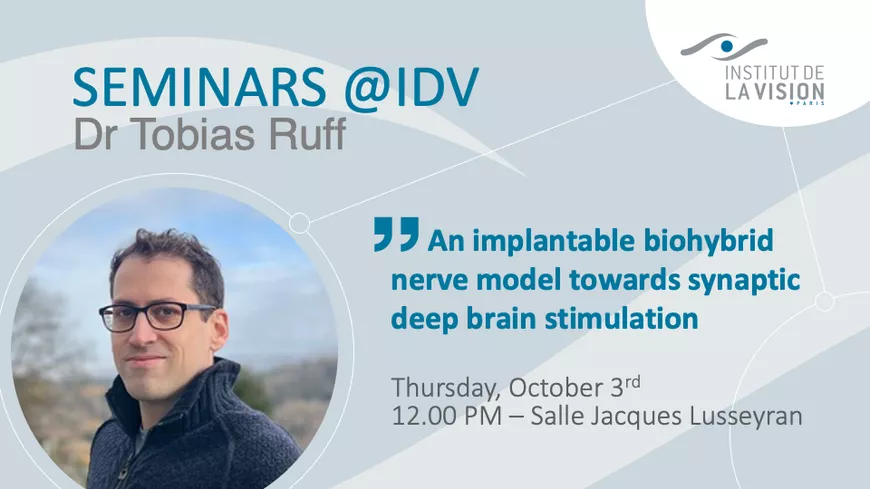An implantable biohybrid nerve model towards synaptic deep brain stimulation
Invited by Florian Fallegger, Tobias Ruff, PhD (ETH, University of Zurich, Switzerland), will speak on Thursday October 3 at 12 noon. Meet in the Jacques Lusseyran room.

Abstract
Available deep brain stimulation electrodes suffer from low stimulation resolution, low biocompatibility and limited coverage of the targeted tissue. To overcome those limitations, we propose a living biohybrid neural interface with the goal of restoring functional vision in the blind without a healthy optic nerve. Our interface uses living on-chip grown retinal neurons as relays to convert electrical signals from a stretchable microelectrode array into synaptic stimulation of a neural target tissue.
Our interface is based on a stretchable micropatterned microelectrode[1,2] array onto which we align axon guiding microfluidic structures that enable unidirectional guidance and merging of axons to form an artificial optic nerve. We increase the biocompatibility of our device by replacing the Polydimethylsiloxane (PDMS) based nerve forming channel with a collagen or gelatin methacryloyl (GelMA)[3] tube that is only 300 µm in diameter and directly integrated onto the PDMS device.
We demonstrate the seeding of retinal spheroids into our biohybrid devices using a modified fluid force microscope. The retinal ganglion cells form an artificial optic nerve up to 3mm long that can transit from the device into the PDMS-bound hydrogel tube to reinnervate a matrigel-based target structure in vitro. We show that we can stimulate individual retinal spheroids using our stretchable microelectrode array. We also present in vitro data on how spikes propagate within the biohybrid implant using CMOS multielectrode arrays. Finally, we present first progress towards in vivo implantation.
References
[1] Raphael F. Tiefenauer, Klas Tybrandt, Morteza Aramesh and János Vörös. Fast and Versatile Multiscale Patterning by Combining Template-Stripping with Nanotransfer Printing. ACS Nano 12.3.2514-2520 (2018)
[2] Nicolas Vachicouras, Christina M. Tringides, Philippe B. Campiche, Stéphanie P. Lacour. Engineering reversible elasticity in ductile and brittle thin films supported by a plastic foil. Extreme Mechanics Letters 15 63-59 (2017)
[3] Hao Liu, Parth Chansoria, Paul Delrot, Emmanouil Angelidakis, Riccardo Rizzo, Dominic Rütsche, Lee Ann Applegate, Damien Loterie, and Marcy Zenobi-Wong. Filamented Light (Flight) Biofabrication of Highly Aligned Tissue-Engineered Constructs. Adv. Healthc. Mater. 2204301, 34.45 (2022)
About Tobias Ruff
Tobias Ruff studied chemistry, biochemistry and neurobiology at Ludwig Maximilian University in Munich, Germany. In 2014, he began his PhD thesis with Prof. Rüdiger Klein and Daniel del Torro at the Max Planck Institute for Neurobiology, where they provided the first biological evidence that cortical fold formation in mice can be induced by modulating the balance between adhesion and repulsion of migrating neurons by manipulating FLRT1/3 levels. At the same time, they characterized a new subtype of retinal ganglion cells in mice. In 2020, Dr. Ruff joined Janos Vörös' laboratory as an HFSP-funded postdoc to continue working on biohybrid neuronal interfaces.
